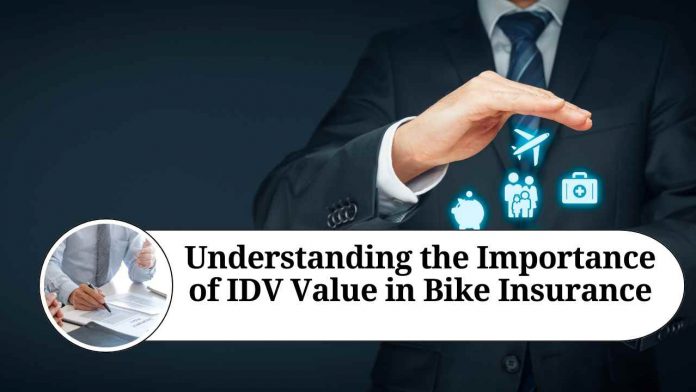Introduction
When it comes to protecting your prized possession, a comprehensive bike insurance policy is a must. One of the crucial factors to consider while purchasing or renewing your bike insurance is the Insured Declared Value (IDV). IDV plays a significant role in determining the coverage, premium, and claim settlement in case of any unfortunate incidents. In this blog, we will delve into the concept of IDV and explore why it is crucial for every bike owner to understand its significance.
What is IDV?
Insured Declared Value (IDV) is the approximate current market value of your bike. It represents the maximum amount the insurance company will compensate you if your bike gets stolen or is completely damaged beyond repair. The IDV is fixed based on the manufacturer’s selling price and the depreciation applicable to your bike’s age. It serves as the benchmark for calculating the premium and claim settlement.
Determining Factors: Several factors influence the calculation of IDV, including:
Age of the Bike: As your bike ages, its value depreciates. The IDV decreases proportionally, considering factors such as wear and tear, market demand, and technological advancements in newer models.
Manufacturer’s Selling Price: The original price at which the manufacturer sells the bike is taken into account while determining the IDV. Accessories and additional fittings, if any, are also considered for evaluation.
Bike Model and Variant: Different models and variants have varying IDV rates. Higher-end models tend to have a higher IDV compared to basic models due to their higher market value.
Geographical Location: The geographical location plays a role in determining the IDV as certain areas may have a higher risk of theft or damage. Hence, the IDV may be adjusted accordingly.
Importance of IDV: Understanding the significance of IDV in bike insurance is crucial for several reasons:
Adequate Coverage: The IDV represents the maximum claim amount you can receive. It is essential to ensure that the IDV is set accurately, neither too high nor too low. Opting for a lower IDV may lead to insufficient compensation, while a higher IDV will result in increased premiums.
Premium Calculation: The IDV directly influences the premium amount. A higher IDV will result in a higher premium, and vice versa. By assessing the IDV value, you can evaluate the premium and choose a policy that best suits your budget and coverage requirements.
Claim Settlement: In the unfortunate event of theft or total loss of your bike, the IDV serves as the basis for claim settlement. It is crucial to ensure that the IDV adequately covers the cost of replacing your bike or compensating for its loss. A lower IDV may result in a significant financial burden during claim settlement.
Policy Renewal: At the time of policy renewal, the IDV is reassessed to reflect the depreciation of your bike over the policy period. It is important to review the IDV during renewal and make necessary adjustments to ensure that you are adequately covered.
Conclusion
The Insured Declared Value (IDV) is a crucial factor in bike insurance that determines the coverage, premium, and claim settlement. Understanding the concept of IDV and its significance allows you to make informed decisions while purchasing or renewing your bike insurance policy. It ensures that you have adequate coverage and receive fair compensation in case of any unfortunate incidents involving your bike. Remember to regularly assess the IDV value to ensure that it aligns with your bike’s market worth and your insurance needs.
Read more useful content:
Frequently Asked Questions (FAQs)
Q1: What does IDV stand for in bike insurance?
A: IDV stands for Insured Declared Value.
Q2: What is the Insured Declared Value (IDV) in bike insurance?
A: The Insured Declared Value (IDV) is the approximate current market value of your bike, which represents the maximum amount the insurance company will compensate you in case of theft or total damage.
Q3: How is the IDV calculated for a bike?
A: The IDV is calculated based on factors such as the bike’s age, the manufacturer’s selling price, depreciation, and any additional accessories or fittings.
Q4: How does the age of the bike affect the IDV?
A: As the bike ages, its value depreciates, resulting in a lower IDV. The older the bike, the lower its IDV will be.
Q5: Can I choose the IDV for my bike?
A: No, the IDV is determined by the insurance company based on predefined guidelines and factors. However, you can select the coverage and policy that best suits your requirements.
Q6: Why is the IDV important in bike insurance?
A: The IDV is important because it determines the coverage amount, premium calculation, and claim settlement. It ensures that you receive adequate compensation in case of theft or total loss of your bike.
Q7: How does the IDV affect the premium amount?
A: The IDV directly affects the premium amount. A higher IDV will result in a higher premium, while a lower IDV will lead to a lower premium.
Q8: What should I consider while assessing the IDV value?
A: When assessing the IDV value, consider factors such as your bike’s market worth, depreciation, age, and any additional accessories or modifications.
Q9: Can I modify the IDV during the policy period?
A: The IDV remains fixed throughout the policy period. However, during policy renewal, the IDV is reassessed based on the bike’s depreciation over time.
Q10: Is it advisable to opt for a higher IDV?
A: Opting for a higher IDV will result in a higher premium. It is important to strike a balance and choose an IDV that adequately covers the cost of replacing your bike without excessively increasing the premium.
Q11: What happens if the IDV is set too low?
A: Setting the IDV too low may result in insufficient compensation during claim settlement. It is essential to ensure that the IDV accurately reflects the market value of your bike.
Q12: Can I negotiate the IDV with the insurance company?
A: The IDV is determined by the insurance company based on predefined factors and guidelines. Negotiation may not be possible, but you can compare different insurance policies to find one with a suitable IDV for your bike.
Q13: How often should I review the IDV of my bike insurance policy?
A: It is advisable to review the IDV of your bike insurance policy at the time of renewal or whenever there are significant changes to your bike’s market value, such as modifications or upgrades.
Q14: Can I insure my bike for an IDV higher than its market value?
A: Insuring your bike for an IDV higher than its market value is generally not allowed. The IDV should reasonably reflect the market worth of your bike.




















